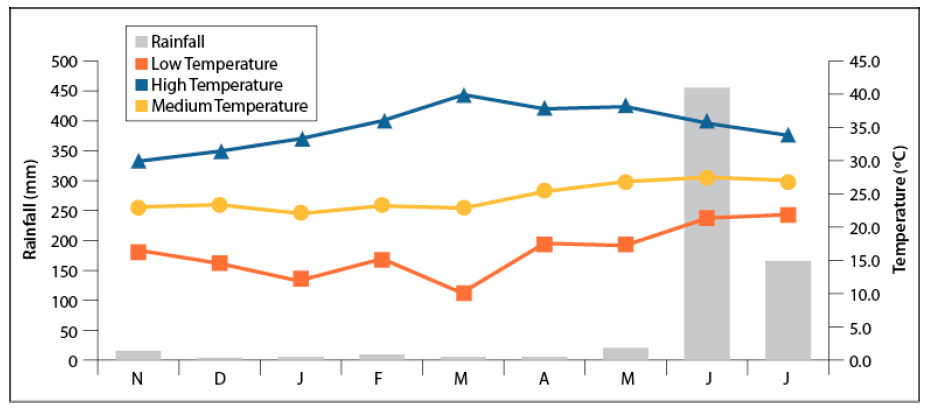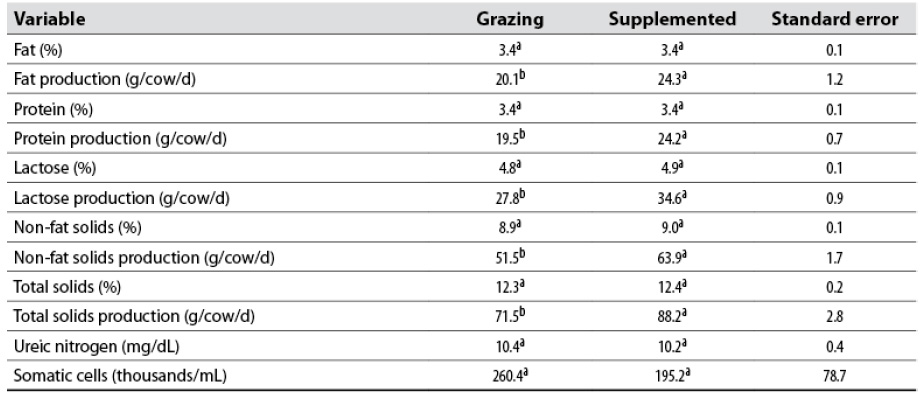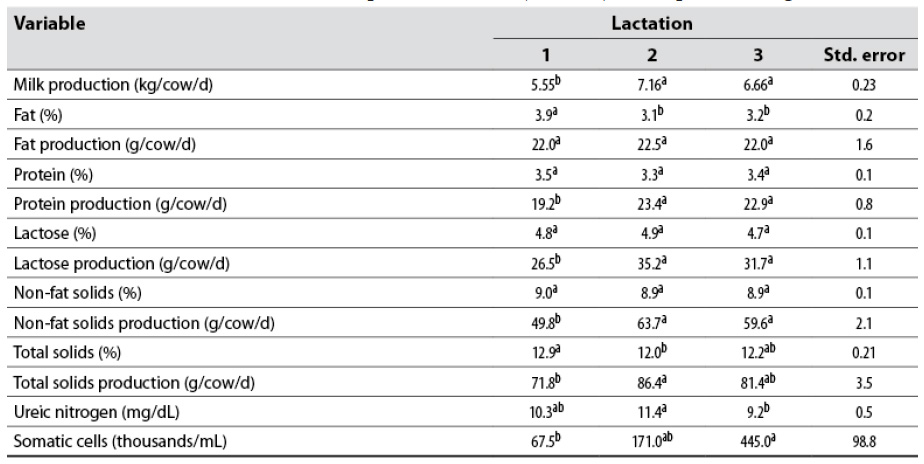Introduction
Dairy systems based on grazing are preferred in intertropical regions with hot climates due, in part, to its low production costs (Martínez-Castro et al., 2012; Muñoz & Deaton, 1981). However, the low seasonal availability and forage quality during drought periods are limiting factors for cows to express their environmental and genetic adaptation potential for milk production. Although the supplementation of grazing cows with commercial feed aims to increase energy intake and improve milk production, the supplementation response varies depending on the production system, the climate, and the genotype of the cow, among other factors (López et al., 2015; Ramos et al., 1998).
The supplementation of Brown Swiss x Cebu cows under grazing conditions in hot climates did not increase milk production significantly when increasing the commercial feed availability from 3 to 4 and 5 kg/cow/d (Martínez-González et al., 2008). Similar results were obtained with Holstein x Cebu cows in silvopastoral grazing systems (López et al., 2015). Álvarez et al. (2007) observed that Argentinean Holstein cows grouped by their production level, did not show differences in milk production when they were supplemented with commercial feed (3.5 and 7.0 kg/cow/d), suggesting that the supplementation response is determined by the genetic potential of the cow within each group. The Holstein breed in temperate climate fed under grazing conditions doubled its milk production when commercial feed supplementation was provided, increasing from 1-2 to 6-8 kg/cow/d (Marín et al., 2018).
Likewise, commercial feed supplementation in dairy cows not only has an effect on the amount of milk produced, but also on its chemical and nutritional composition. An increase in the proportion of nonstructural carbohydrates can decrease the fat content of milk (Ramos et al., 1998). Furthermore, when commercial feed supplementation increased from 1 to 2 kg/cow/d, the total solids milk content decreased by 0.5 % (Razz & Clavero, 2007).
The Tropical Milking criollo (LT) breed is characterized by its hardiness in hot climates of the intertropical zone, tolerance to diseases, and the ability to graze in search of feed (De Alba, 2011). Some of its economic importance traits are its high milk quality and cheese yield (Santellano-Estrada et al., 2011). Cows show a lactation value of 1,174 ± 11.4 kg of milk at 305 d with percentages of fat, protein, and total solids of 3.9 ± 0.2, 3.9 ± 0.2, and 12.7 ± 0.3, respectively, and a cheese yield of 5.9 kg of milk to obtain one kg of fresh cheese (Rosendo-Ponce & Becerril-Pérez, 2015). Corrales (2011) reported 1,319 ± 417 kg in 305 days of lactation in the Nicaraguan criollo breed Reyna.
The supplementation effect in LT grazing cows is poorly known and could increase their milk production; however, it could also change its chemical composition. LT cows milked twice a day and supplemented with 22 % protein feed produced 17 % more milk than cows solely under grazing (Domínguez-Pérez et al., 2011). Accordingly, the aim of this study was to evaluate in LT cows the supplementation with commercial feed in a traditional production grazing system concerning the quantity and physicochemical traits of the milk produced by lactation.
Materials and methods
Study area
The study was carried out in the Leeward Region of Veracruz, Mexico (19.2°N, 96.3°W) at 20 m a.s.l. The climate of the region is classified as Aw0(w)(i')gw'' (García, 2004), hot sub-humid with summer rains distributed from May to October, with an average annual rainfall of 1,060 mm and an average temperature of 26.4 °C.
Experimental procedure
Twenty-four LT cows of first, second and third lactation of 1,160 ± 68, 1,756 ± 75, and 2,264 ± 62 d of age, respectively, were included in this study. Each cow was assigned to one of four groups of six cows according to the calving date, with two cows per lactation number. Calvings occurred from October 2015 to March, 2016 with low rainfall, and the experimental lactation period was considered from November 2015 to July 2016 (figure 1). The feeding treatments were: 1) based only on para grass Brachiaria mutica (Forssk.) Stapf (Poaceae) under rotational grazing, and 2) based on para grass under rotational grazing plus 20 % commercial protein feed supplementation at a dose of 1 kg/cow/d for every 5 kg of milk produced. The treatments were randomly assigned based on cow availability, according to their calving dates.

Source: Elaborated by the authors based on climatic data Instituto Nacional de Investigaciones Forestales, Agrícolas y Pecuarias (INIFAP, 2016)
Figure 1 Rainfall and temperature recorded at the study site throughout the experimental period. Months: Starting in November (N) 2015 and ending in July (J) 2016
Animal management and data collection
Traditional milking was done once a day by hand with the calf standing beside the dam, from 7:00 to 8:30 hours. The udder was disinfected with a 7 % iodinated compound (Triodine-7®), and then washed and dried with clean cotton cloths. Cows were artificially inseminated (AI) with no assistance during calving. No chemical products were used against ticks, and few sanitary practices were performed.
Grazing was carried out in low or flooded area paddocks, with residual moisture in the soil during the dry season and possible floods during the rainy season, in an area of 20 ha divided into 16 paddocks of 1.25 ha each with para grass. The cows stayed two or three days in each paddock according to forage availability; the resting period was 32 to 48 d per paddock.
All the animals were given water in the paddock and they had access once a month to 12 % phosphorus and calcium mineral salts (Fosforysal 120 L®). The supplemented cows were provided 20 % crude protein (commercial feed Generaleche 1056-20® - Purina®) during milking. The dose for each cow was determined based on the milk produced in its previous weighing. Every 21 d during the first 120 d of lactation, the total milk produced was weighed with a clock scale (DETECTO®), and a 100 mL sample was collected per cow to determine the chemical composition of milk adding bronopol (2-bromine-2-nitro1, 3-propanediol) as a preservative.
Five samples of commercial feed were taken for analysis. Every 15 d, a forage sample was collected per paddock before each grazing with a metal quadrant of 1 m2 at the height of 10 cm from the ground, emulating the harvesting height of cows. The samples were dried in a forced-air oven at 60 °C for 48 h to determine the content of protein, ash, and etheric extract employing the micro Kjeldahl (Labconco®), muffle (Lindberg®), and Soxhlet extractor techniques using the methodologies described by AOAC Internacional (2005). Neutral detergent fiber and acid detergent fiber were obtained by the techniques described by Van Soest et al. (1991). A dose of 8 g of chromium oxide was given per cow for 15 d in three periods (January, March, and April); during the last 5 d of each period, feces samples were taken directly from the rectum, and milk was discarded.
The five samples per cow within the same period were mixed to form a single composite sample that was analyzed. Acid-insoluble ash (AIA) was determined in feces, commercial feed, and forage samples. Total dry matter intake (TDMI, kg/d) was determined by adding the amount of fodder consumed from the grass, and the concentrate offered daily per cow. Dry matter fecal production (DMFP, g/d) and dry matter grass intake (DMGI, kg/d) were estimated with the equations described by Church (1988) and Geerken et al. (1987) as follows:
The total dry matter digestibility (TDMD) was estimated with the equation described by Church (1988), as follows:
Response variables
Besides TDMI and TDMD, milk production (MP, kg/d) and its components, such as fat (F, %), protein (P, %), lactose (L, %), non-fat solids (NFS, %), total solids (TS, %), and ureic nitrogen (UN, mg/dL) were determined by medium infrared spectroscopy (Lacto Scope FTIR®). The number of somatic cells (SC, thousands/mL) was established by flow cytometry (Soma Scope MK2®). The total daily production of fat (FP, g/d), protein (PP, g/d), lactose (LP, g/d), non-fat solids (NFSP, g/d), and total solids (TSP, g/d) were determined by multiplying MP by the percentage of each of the components.
Statistical analysis
The data was analyzed with the following statistical model:
Where:
Yijklm = variable; μ = Population constant; Si = Fixed effect of the i-th level of supplementation (i = 1, 2); Gj = Fixed effect of the j-th group (j = 1, 2, 3, 4); Nk = Fixed effect of the k-th lactation (k = 1, 2, 3); Vl(ijk) = Random effect of the l-th cow, nested in the i-th supplementation level, j-th group, and k-th calving, Vl(ijk) ~ Normally, Independent and Identically Distributed NIID (0, σ2v); Mm(j) = Fixed effect of the m-th sampling, nested in the j-th group (m = 1, 2, 3, 4, 5, 6), y ϵijklm = Random error, ϵijklm ~ Normally, Identically Distributed NID (0, σ2e).
The sampling effect corresponded to repeated measurements in the same cow. For the SC data analysis, the logarithmic transformation was used; however, the means are presented in the original scale. The data were analyzed with the MIXED procedure of the SAS® 9.3 software (SAS Institute, 2010) with covariance structure in an integrated autoregressive model of moving averages, and the comparison of means was performed with Tukey's test (α = 0.05).
Results and discussion
The mean chemical composition of the grass and the commercial feed is presented in table 1; as widely known, there are significant differences in the chemical composition between forages and concentrate feeds. Differences of more than double were observed in protein content, less than half in neutral detergent fiber, less than one quarter in acid detergent fiber, and more than triple in etheric extract content in the commercial feed compared to forages. High-quality para grass was employed in the current study as it has high protein content and similar neutral detergent fiber (Alam et al., 2015; Meléndez-Nava, 2012). Commercial concentrates have high energy and protein, and low crude fiber compared with roughages and are comprised of very small particles; high protein content concentrates have over 18.0 % crude protein (SNV, 2017).
Table 1 Chemical composition (%) of para grass (Brachiaria mutica) and commercial feed provided to Tropical Milking criollo cows under grazing and supplementation conditions

Source: Elaborated by the authors
The difference in MP between treatments was 1.28 kg/cow/d in favor of the supplemented cows (p ≤ 0.05, table 2), which corresponds to 22 %, and represents a 153.6 kg of milk difference during the study period of 120 d, even when the TDMI was similar (p > 0.05). The MP obtained in this study is higher than that observed in common cows in Veracruz, with an average production of 3.47 kg/cow/d (Cervantes-Acosta et al., 2015), and also in the Nicaraguan Reyna with 4.31 kg/cow/d (Corrales, 2011). Milk production in both treatments, i.e., grazing and supplementation with commercial feed, was lower than the values recorded in previous studies with LT cows milked twice a day with values of 6.91 and 8.09 kg/cow/d, respectively; nonetheless, MP increases about 20 % with a second milking (Domínguez-Pérez et al., 2011). However, MP levels were similar to those found in the Brown Swiss x Cebu cows under grazing and employing similar supplementation conditions (López et al., 2015; Saborío-Montero et al., 2015).
In the intertropical zone with hot climates, Brown Swiss cows under grazing and supplementation with 4.5 kg/cow/d of commercial feed, produced 7 kg/cow (Salvador-Loreto et al., 2016). Whereas, Bos taurus x Bos indicus cows grazing on Urochloa and Brachiaria and in silvopastoral systems with Brachiaria sp. and the shrubby species Tithonia diversifolia (Hemsl.) A. Gray (Asteraceae) at a density of 5,000 plants/ha, produced 4.6 and 4.9 kg/cow/d of milk, with 3.54 % and 3.48 % of fat, respectively (Rivera et al., 2015).
In the current study, LT cows showed a response to supplementation and grazing capacity; the amount of commercial feed supplemented to the cows that consumed para grass only, managed to modify the forage-concentrate ratio by 90-10; nevertheless, it was enough to increase the daily milk production by 22 %. In grazing dairy cows, supplementation with commercial feed can improve ruminal fermentation due to its starch content; though, supplementation of 5 % level TDMI with a commercial feed did not improve ruminal fermentation; on the other hand, this was achieved with supplementation of 10 % level plus a higher gas production the first 24 h (López et al., 2014). In the current study, the rumen fermentation rate was not measured; however, supplementation improved the ruminal fermentation of LT cows due to a higher digestibility (p ≤ 0.05, table 2). Better digestibility can increase the amount of volatile fatty acids in the rumen, and specifically, propionate increases blood glucose levels (Seymour et al., 2005). The mammary gland cells use glucose to synthesize lactose that regulates the amount of secreted milk (Campabadal, 1999). This may explain the increase in MP in supplemented LT cows.
Table 2 Productive performance and feeding traits in grazing and supplemented Tropical Milking criollo cows

a, b:Means with different superscript letters in the same row show statistical differences (p ≤ 0.05).
Source: Elaborated by the authors
The MP increase of the supplemented cows does not modify (p > 0.05) the chemical composition of the milk in any of its components, nor its sanitary condition (table 3), in agreement with Domínguez-Pérez et al. (2011). However, it was enough to increase significantly (p ≤ 0.05) the daily production of each component in favor of the supplemented cows. Fat is the milk component that is easiest to modify through changes in the diet, mainly, by modifying the proportion of acetate, propionate, and butyrate in the rumen (Ramos et al., 1998). A decrease in fat is achieved by exceeding by 25 %, the propionate proportion in the rumen (Campabadal, 1999). In the current study, fat was similar in both treatments (p > 0.05), probably because the forage-commercial feed rate in supplemented cows did not modify the molar concentration of propionate in the rumen. It only increased the ruminal flora population without altering the acetate and propionate proportion of producing bacteria.
The supplemented cows also showed a higher total daily production for every milk component (p ≤ 0.05) explained by the multiplicative effect of a higher dairy yield per cow and day (Domínguez-Pérez et al., 2011). Meanwhile, for FP, PP, NFSP, and TSP, it exceeds the values obtained in the current study with 3.8 ± 0.9, 3.8 ± 0.6, 9.1 ± 0.6, and 13.0 ± 0.9 g/d, respectively (Cervantes-Acosta et al., 2015), probably due to the diet effect or to the increased production of milk in LT cows assessed in the current study.
The UN level indicates the amount of blood urea, which, in turn, indicates the efficiency in the use of nitrogen by the cow (Sánchez-Salas, 2016). In the current study, the UN was below the range of 12-15 mg/dL, which is considered adequate in dairy cows (Cerón-Muñoz et al., 2014), and could indicate a protein deficit in the diet. Commercial feed supplementation in LT cows failed to modify the UN (p > 0.05). This indicates that the supplementation level did not provide enough structural carbohydrates to take advantage of the ammonia level in the rumen more efficiently. The UN decreased with lactation number, which suggests a decrease in the metabolism of amino acids, and consequently, a reduction in urea production in the liver as the cow age increases (Vargas-Sobrado et al., 2016).
Table 3 Chemical composition and milk production of grazing and supplemented Tropical Milking criollo cows

a, b:Means with different superscript letters in the same row show statistical differences (p ≤ 0.05).
Source: Elaborated by the authors
First lactating cows produced 29 % less milk (p ≤ 0.05), although with higher fat content, highlighting a low SC count, which increased in cows with two and three lactations (table 4). Other studies, showed a 16 % to 26 % deficit for MP in first lactating cows compared to those with multiple lactations (Castillo-Umaña et al., 2017; Ríos-Utrera et al., 2015); however, they reached their maximum production at the third lactation, whereas in this study, the TM cows reached it in the second one.
Table 4 Production and chemical composition of milk (lactation) of Tropical Milking criollo cows

a, b, c:Means with different literals in the same row show statistical differences (p ≤ 0.05). Std. error: standard error
Source: Elaborated by the authors
Fat decreased as calvings increased. This is similar to what has been found in Holstein and Jersey cows due to increases in MP and calving number. Conversely, there was a negative phenotypic relationship between MP and fat; for P, L and NFS, there were no significant differences between lactations; in some studies, P decreased as the number of lactations increased (Vargas-Sobrado et al., 2016). In the current study, the SC count increased with lactation number, similar to what Mora et al. (2016) recorded; as the number of calvings increase, cows are more exposed to contagions, possible infections, and greater breast tissue deterioration, so the number of somatic cells present in the milk could increase.
Conclusions
The supplementation of 1 kg/cow/d of commercial feed per each 5 kg/cow/d of milk produced, increased 22 % the milk production in cows of the Tropical Milking criollo breed under grazing conditions without affecting the chemical composition of milk; on the other hand, lactation number affected the chemical composition of milk. Thus, it is feasible to improve the milk yield through supplementation without changing its composition.











 texto em
texto em 







